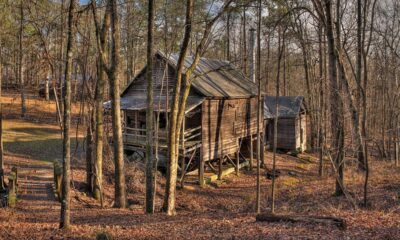New York
How a 5-foot porter from Albany became America’s first Black war hero in WWI France
Published
2 months agoon

Henry Johnson’s Heroic Stand Against Overwhelming German Forces
The Harlem Hellfighters Memorial in New York honors soldiers who fought harder for respect than victory.
Henry Johnson was a 5-foot-4-inch railroad porter from Albany who enlisted in 1917 with the all-black 369th Infantry Regiment.
White American troops refused to fight alongside them, so they were assigned to the French Army.
On May 15, 1918, Johnson and teenager Needham Roberts faced 25 German soldiers in brutal hand-to-hand combat in the Argonne Forest.
Johnson’s rifle jammed, so he used it as a club until it splintered, then grabbed his knife. He killed four Germans and wounded twenty others while suffering 21 wounds himself.
France immediately awarded him their highest military honor, but America ignored his heroism for decades. This black granite memorial tells the full story of Johnson’s incredible night of combat.

Two Soldiers Stood Watch in the Argonne Forest
Henry Johnson and Needham Roberts took their spots early on May 15, 1918.
The two Black American soldiers from the 369th Infantry Regiment guarded an outpost in France’s Argonne Forest from midnight to 4 a. m.
Johnson, a short former railroad porter from Albany, looked into the darkness while 17-year-old Roberts kept watch beside him.
Their unit joined the French Army because white American troops refused to fight with Black soldiers. The quiet forest gave no hint of the coming violence.

Wire Cutters Made a Telltale Sound in the Darkness
Around 2 am, Johnson heard something that made his skin crawl, the clear snip of wire cutters. He told Roberts as they looked into the dark.
German soldiers cut through the barbed wire around their outpost. Johnson threw a grenade toward the sound while Roberts ran to alert nearby French troops.
Before Roberts got far, about 25 German soldiers came from the shadows, surrounding the two Americans in one of the most uneven fights of World War I.

Germans Launched Grenades at the Outnumbered Americans
The German squad attacked hard, throwing grenades at the two American guards. One blast knocked Roberts down with many wounds to his arm and hip.
Johnson took shrapnel but kept fighting. The Germans thought they would easily beat the small outpost, but Johnson fought back fiercely.
Though facing more than ten enemies, Johnson stood firm and fired his French rifle. He also threw grenades back at the Germans, creating chaos as they tried to rush his position.

Roberts Passed Grenades While Bleeding on the Ground
Despite bad injuries, Roberts leaned against a tree stump and handed grenades to Johnson from their shrinking supply. The hurt teenager couldn’t stand but refused to give up.
Johnson moved around, throwing grenades and firing his rifle while protecting his fallen friend. The Germans kept coming, set on catching or killing the Americans.
When the grenades ran out, Roberts fought with his rifle until he couldn’t lift it. Johnson now faced the remaining German soldiers alone as they closed in.

The Rifle Became a Deadly Club When Bullets Ran Out
Johnson’s rifle jammed when he tried loading American bullets into the French weapon. Without pause, he swung the rifle like a baseball bat, smashing it into the face of the nearest German soldier.
The wooden stock crashed against skulls and shoulders as Johnson fought off the attackers. He kept swinging until the rifle broke from the force of his blows.
Several Germans fell from his fierce counter-attack, but more kept coming. With his main weapon broken and Roberts badly hurt, Johnson grabbed his last remaining tool.

A Bolo Knife Turned the Tide of Battle
With his rifle broken, Johnson pulled out his bolo knife, a heavy, machete-like blade given to many American soldiers. The Germans rushed forward to grab Roberts, who lay hurt and helpless.
Johnson charged straight into the German group, cutting and stabbing with surprising speed. His knife flashed in the dark as he cut through the German ranks.
The raiders didn’t expect such fury from the outnumbered Americans.
Johnson stabbed his way through several soldiers, forcing others to back away from his non-stop attack.

Blood Covered the Battlefield as Johnson Fought On
Johnson’s knife hit its mark again and again as he fought to protect Roberts. He stabbed one German soldier in the skull and cut the throat of another.
Blood covered his uniform and hands as he kept fighting despite getting many wounds. The Germans shot him several times and stabbed him with bayonets, but Johnson refused to fall.
He killed four German soldiers and hurt between 10 and 20 others during the brutal close combat. By the battle’s end, Johnson had 21 separate wounds yet somehow stayed on his feet.

The Wounded Porter Dragged His Friend to Safety
After pushing back the German raiders, Johnson went back to Roberts.
Despite his own bad injuries, Johnson lifted the wounded teenager onto his shoulder and started carrying him toward friendly lines. Blood poured from Johnson’s wounds as he stumbled through the forest with his comrade.
The former railroad porter, who had loaded bags at Albany’s Union Station before the war, now used his last bit of strength to save his friend.
He fell several times but got back up, not wanting to leave Roberts behind if the Germans came back.

French Reinforcements Found a Battlefield Littered with Bodies
When French troops came at dawn, they found a bloody scene around the outpost.
Dead and wounded German soldiers lay scattered on the ground, with blood trails leading back into the forest where others had dragged hurt comrades away. Johnson and Roberts both lived despite their injuries.
The French soldiers counted the German losses and listened in shock as other American troops told what the two men had done.
News of the battle spread quickly through Allied lines, and commanders visited the wounded heroes in the field hospital.

France Honored the Black Americans When America Wouldn’t
The French government quickly recognized Johnson’s amazing bravery, giving both men the Croix de Guerre, France’s highest military honor.
Johnson got the extra mark “avec Palme,” becoming the first American to get this level of the award in World War I. The French celebrated Johnson while the U.S. military mostly ignored his heroism.
After the war, Johnson went back to Albany with no American medals, no disability pay despite his wounds, and no thanks from the country he served.
He died poor and forgotten in 1929, decades before America would admit his bravery.

The Legend of "Black Death" Spread Through Europe
German troops gave Johnson the nickname “Black Death” after survivors told stories of his fierceness in battle. French newspapers celebrated the Albany porter who had fought off an entire German patrol.
Johnson briefly became famous, appearing on Army recruiting posters and speaking at bond drives. But fame faded quickly for Black veterans returning to segregated America.
Johnson received no U. S. military honors until 1996 when President Clinton awarded him the Purple Heart posthumously.
President Bush added the Distinguished Service Cross in 2002, and in 2015, President Obama finally awarded Johnson the Medal of Honor, nearly a century after his night of extraordinary courage.

Visiting Harlem Hellfighters Memorial
The Harlem Hellfighters Memorial at Fifth Avenue and 142nd Street honors Henry Johnson and the 369th Infantry Regiment. This free outdoor monument is a 12-foot replica of the 1997 memorial in Sechault, France.
You can see the 369th crest and commemorations of battles at Ripont, Mont-Cuvelet, and Sechault. The 369th Armory with historical exhibits is right across the street at One West 142nd Street.
This article was created with AI assistance and human editing.
Read more from this brand:
John Ghost is a professional writer and SEO director. He graduated from Arizona State University with a BA in English (Writing, Rhetorics, and Literacies). As he prepares for graduate school to become an English professor, he writes weird fiction, plays his guitars, and enjoys spending time with his wife and daughters. He lives in the Valley of the Sun. Learn more about John on Muck Rack.


15 mountain towns in America where fall feels like a painting

This Connecticut submarine museum boasts the Cold War’s most desperate shopping trip

This Colorado town was literally built to shame its sinful neighbor

The drive that shows Maryland like you’ve never seen before

If You Understand These 14 Slang Terms, You’re Definitely from Arkansas

12 Reasons Why You Should Never Ever Move to Florida

Best national parks for a quiet September visit

In 1907, Congress forced Roosevelt to put God back on U.S. coins. Here’s why.

The radioactive secret White Sands kept from New Mexicans for 30 years

America’s most famous railroad photo erased 12,000 Chinese workers from history
Trending Posts

 Pennsylvania4 days ago
Pennsylvania4 days agoHere Are 12 Things People from Pennsylvania Do That Seem Insane To Everyone Else

 North Carolina5 days ago
North Carolina5 days agoHere Are 12 Things People from North Carolina Do That Seem Insane To Everyone Else

 Maine6 days ago
Maine6 days agoThe ruins of a town that time forgot are resting in this Maine state park

 New York5 days ago
New York5 days agoHere Are 12 Things People from New York Do That Seem Insane To Everyone Else

 South Carolina3 days ago
South Carolina3 days agoHere Are 12 Things People from South Carolina Do That Seem Insane To Everyone Else

 Ohio5 days ago
Ohio5 days agoHere Are 12 Things People from Ohio Do That Seem Insane To Everyone Else

 Georgia6 days ago
Georgia6 days agoThis plantation’s slave quarters tell Georgia’s slowest freedom story

 New Hampshire6 days ago
New Hampshire6 days agoHere Are 12 Things People from New Hampshire Do That Seem Insane To Everyone Else
